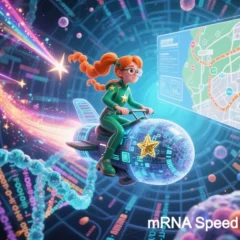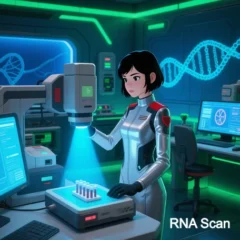CRISPR (Clustered Regularly Interspaced Short Palindromic Repeats) is a revolutionary gene-editing technology derived from a natural bacterial immune system.
Key points:
Uses a guide RNA to direct the Cas9 protein to cut specific DNA sequences.
Allows precise insertion, deletion, or modification of genes.
Applications: curing genetic diseases, improving crops, biomedical research.
Nobel Prize in Chemistry (2020) awarded to Doudna & Charpentier for its discovery.
It’s faster, cheaper, and more accurate than older gene-editing methods.

mRNA Speed
mRNA Speed: Accelerated Development and Production Technologies mRNA Speed refers to the end-to-end acceleration of mRNA vaccines and therapeutics from sequence design to large-scale production. By integrating modular platforms, synthetic biology innovations, and industrialized manufacturing systems…

mRNA Velocity
Applications and Key Advances of mRNA Velocity mRNA Velocity is a groundbreaking analytical technique based on single-cell RNA sequencing (scRNA-seq) that quantifies the dynamic ratio of unspliced to spliced mRNA to predict future cellular states and developmental trajectories. By adding a temporal …

Modified RNA
Applications of Modified RNA in Gene Therapy Modified RNA technology has significantly enhanced the precision, safety, and applicability of gene therapy through chemical or sequence optimization. Below are representative case studies and mechanistic insights into its therapeutic applications: I. Gen…

RNA Tools
RNA Tools: Categories and Advances in Gene Editing Technologies RNA tools have become pivotal in modern molecular biology and gene therapy, with their applications rapidly expanding. This review systematically categorizes RNA tools, highlights recent technological breakthroughs (as of May 2025), and…

RNA Primer
RNA Primers vs. DNA Primers: Core Differences and Applications RNA primers and DNA primers are two critical nucleotide sequences in molecular biology, serving distinct roles in genetic information transfer in vivo and in vitro. Below is a systematic comparison across five dimensions: composition, fu…

RNA Splic
RNA Splicing: The Precision-Driven Link Between Transcription and Translation RNA splicing is a critical biological process that ensures the accurate conversion of genetic information from pre-mRNA to mature mRNA. By removing non-coding introns and joining exons, splicing bridges transcription and t…

RNA Scan
Synergistic Application of RNA Scan Technology with Clinical Diagnostics: Reshaping Modern Medicine The integration of RNA Scan technology with other clinical diagnostic methods is revolutionizing medical diagnosis and treatment paradigms. This multi-dimensional synergy enhances detection accuracy a…

RNA Scan
RNA Scan Technology: Core Mechanisms and Pathways for High-Precision RNA Detection RNA Scan technology combines specific probe design and multi-level signal amplification systems to achieve highly sensitive and specific RNA detection. Below is an in-depth analysis of its core principles, technical b…

RNA Enzymes
Ribozymes in Biotechnology: Core Applications and Future Prospects (2025 Update) I. Biological Properties and Unique Advantages of Ribozymes Ribozymes are RNA molecules capable of catalyzing biochemical reactions, challenging the traditional view that "enzymes are proteins." Their key advantages inc…

GenRNA.com
Sustained Innovation in Plasmid Technology: Recent Achievements and Future Prospects in Biomedicine and Industry (2025 Update) I. Biomedicine: From Gene Therapy to Vaccine Revolution 1. Gene Editing and Precision Therapy Ultra-Precise CRISPR-Cas9 Systems: AI-optimized Cas9 variants (e.g., HypaCas9) …










